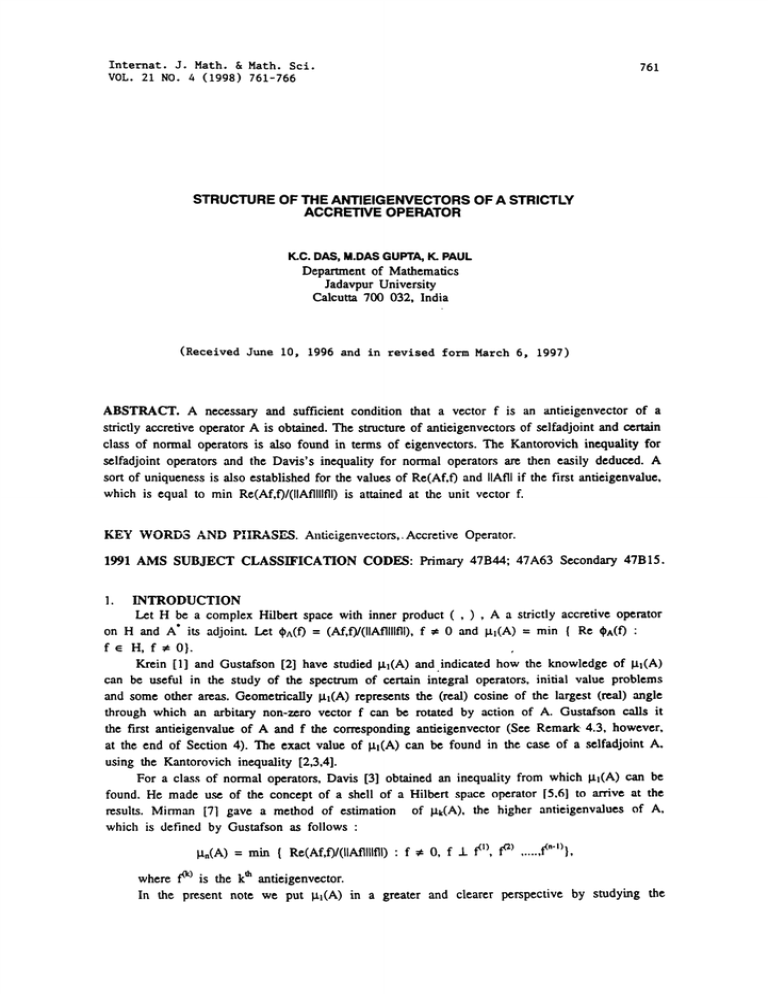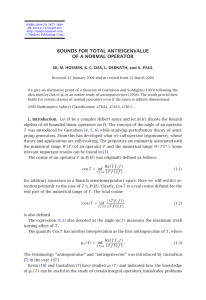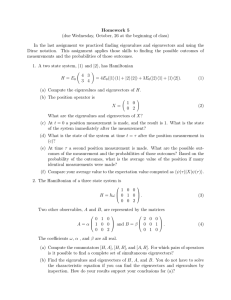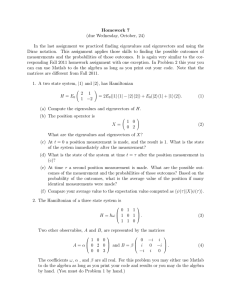Document 10458447
advertisement

Internat. J. Math. & Math. Sci.
VOL. 21 NO. 4 (1998) 761-766
761
STRUCTURE OF THE ANTIEIGENVECTORS OF A STRICTLY
ACCRETIVE OPERATOR
K.C. DAS, M.DAS GUPTA, K. PAUL
Department of Mathematics
Jadavpur University
Calcutta 700 032, India
(Received June i0, 1996 and in revised form March 6, 1997)
ABSTRACT. A necessary and sufficient condition that a vector f is an antieigenvector of a
strictly accretive operator A is obtained. The structure of antieigenvectors of selfadjoint and certain
class of normal operators is also found in terms of eigenvectors. The Kantorovich inequality for
selfadjoint operators and the Davis’s inequality for normal operators are then easily deduced. A
sort of uniqueness is also established for the values of Re(Af, f) and IIAfll if the first antieigenvalue,
which is equal to min Re(Af,f)/(llAfllllfll) is attained at the unit vector f.
KEY WORDS AND PIIRASES. Antieigenvectors,.Accretive Operator.
1991 AMS
SUBJECT CLASSIFICATION CODES:
Primary 47B44; 47A63 Secondary 47B15.
INTRODUCTION
A a strictly accretive operator
Let H be a complex Hilbert space with inner product
on H and A" its adjoint Let A(O (Af,fff(llAfllllfll), f 0 and I.t(A) min Re ^(f)
f H, f 0}.
I.
Krein [1] and Gustafson [2] have studied I.tl(A) and indicated how the knowledge of I.tl(A)
can be useful in the study of the spectrum of certain integral operators, initial value problems
and some other areas. Geometrically lxt(A) represents the (real) cosine of the largest (real) angle
through which an arbitary non-zero vector f can be rotated by action of A. Gustafson calls it
the first antieigenvalue of A and f the corresponding antieigenvector (See Remark, 4.3, however,
at the end of Section 4). The exact value of I.tt(A) can be found in the case of a selfadjoint A.
using the Kantorovich inequality [2,3,4].
For a class of normal operators, Davis [3] obtained an inequality from which I.t(A) can be
found. He made use of the concept of a shell of a Hilbert space operator [5.6] to arrive at the
results. Mirman [7] gave a method of estimation of k(A), the higher antieigenvalues of A,
which is defined by Gustafson as follows
gn(A)
min
Re(Af,f)/(llAfllllfll)
f, 0, f I
fo), :)
where f0o is the kt antieigenvector.
In the present note we put tx(A) in a greater and clearer perspective by studying the
K. C. DAS, M. DAS GUPTAAND K. PAUL
762
that make Re(Af,f)/(llAfllllfll), f 0. stationary. (For definition see Section
2). We call them stationary vectors. Clearly every antieigenvector is a stationary vector. We show
that for selfadjoint and normal operators a suitable combination of two distinct eigenvectors yields.
a stationary vector while the converse is true for all selfadjoint and a certain class of normal
operators. Kantorovich inequality and Davis’s inequality all follow as immediate consequences. If
the first antieigenvalue, namely rain Re A(f)
min Re(Af,f)/(llAfllllfll), f 0 is attained for a
unit vector f then it is shown that the values of Re(Af,f) and IIAfll are unique. An equation
characterizing vectors for which I^(f)l is stationary, is also given. A recursive variational scheme
is used to define higher antieigenvalues.
st’ucture of the vectors
STATIONARY VALUES OF Re ^(f)
A’A. Both
let A be a strictly accretive operator on H and Let B
(A + A’)/2 and C
the operators B and C are obviously positive definite. Re ^(f) represents the cosine of the real
angle of rotation of the vector f under the action of A. Re %(0 is said to have a stationary
value at a vector f (4 0) if the function ws(t) of a real variable t, defined by
2.
(Bf +
ws (t)=
(Of+ tCg,f + tg)
tB,f + t)
f + tg, f+ tg)
(2.1)
has a stationary value at
0 for any arbitrary but fixed vector g. In other words we must.
b and (Cf,f) c2. With these notations.
0 for all g. For lIfll
have w’ (q)
set (Bf,f)
we e that Re (n(O is stationary at f iff
2c2Re
(BLg)
b Re (CLg)
bc Re (f.g)
0.
(2.2)
Since g is arbitrary, we have the following theorem.
THEOREM 2.1. Let A(f), b and c be defined as above. A unit vector f is a stationary
vector of Re %(0 iff
c2(A
+
A’)f- bA’Af- bc2f
0
(2.3)
Equation (2.3) obviously characterizes the vectors for which Re q)A(0 is stationary, in particular.
a minimum or a maximum.
COROLLARY 2.1. ff for a stationary vector f, Af A’f then f is a linear combination
of two eigenvectors Af c2/b f :1: c/b /c-b f of A* with corresponding eigenvalues c2/b +
If in addition A is normal then f is a linear combination of two cigenvectors Af+_. c/b /c-bf of A with corresponding eigcnvalues cb + c/b /c2-’b2’
c/b
f
STATIONARY VALUF OF ^(I’) FOR SELFADJOINT OPERATORS
For a selfadjoint operator A we can obtain the structure of the stationary vectors of RA(f)
(which is obviously equal to ^(f) in this case), in particular, of the antieigenvectors in terms of
2
(m + M) "l, where as usual tn, M are the
the eigenvectors. It will follow that tl(A)
3.
least and the greatest eigenvalues of A respectively. This is the Kantorovich inequality (see [3]
and [4]). We now state
THEOREM 3.1. A unit vector f is a stationary vector of a selfadjoint operator A iff there
exism two eigenvectors whose appropriate linear combination (in the sense given below) yields f.
PROOF. If f is a stationary
vector, in particular an antieigenvector then it satisfies
(2.3).
763
A STRICTLY ACCRETIVE OPERATOR
As A is selfadjoint (2.3) reduces to
IIAfll 2Af- (Af, f)A2f- (Af.f) IIAfl, lf O which implies A2f IIAfll/O^(f) Af :1: Ilhll/O^(f) Af
IIAflY^(f) Af- IIAfll2f + Ilhll/ 0h(f) Af where h Af Xf, with (f,h) 0 and X (Af,f).
that is
A[Af-IIAfil/0^(0 f + Ilhll/O^(0 f
(llAfli+ Ilhll)/O^(f) [Af-IIAf It/q^(f) f’& IIh, ll/O^(0 f]
(llAfll + Ilhll) /^ (f) t (llAfll- Iihll)/O^(0
Af- f g Af- I.tlf, then Ag
gl
g2 and f l/(I.tt-) (gt’g2)"
I.ttgl, Ag
So that f is a linear combination of two eigenvectors.
Let I.t
Conversely, let f
Ixie + ojej, with o
2
=
J
and
I ,1
where e and e
are any two eigenvectors of A corresponding to eigenvalues
So b
%,il(xi, = +
(Af,f)
.,
and
we can (2.3) see that the equation (2.3) is satisfied by f. This completes the proof.
The Kantorovich inequality (see [2], [3] and [4]) now follows as a corollary.
COROLLARY 3.1. If A is selfadjoint and I.t(A) minl(Af,0/(llAflllll]l) f e H, f
0}
2"-/ (m + M).
then la(A)
PROOF. One need only to observe that I.tt(A) is stationary value of ,(0 and
/
2 / (./ + /.) assumes the least value for greatest /2, which
+ %i
2/’%i
in this case is M/m.
4.STATIONARY VALUES OF Re ^(t’) FOR A NORMAL OPERATOR
Before we discuss the structure of the stationary vectors in the normal case, we give a
few examples to show that the situation in this case can be very different. In these examples
ek’ s are eigenvectors of A corresponding to eigenvalues 2:’s, the values of which are clear from
the context
, c=
EXAMPLE 4.1. Let A be normal with Af
El(f,e0l
Z(t+k) t(f,ek)l
=. Hence b:/c
/’Si-, Ilfll
E(l+ik) (f,ek)ek,
t/[z(+k=)l(f,e01=l.
1/(1 + n), where n
=1. So b
Obviously, Re
.
max {k}.
(1 + i) (f, ei)e + (1 i) (f, ea)e2 + (2 + i) (f, e3)e3 + (2 i)
Z’i", Ilflll=l. So b
2 + 3 I(f,e3)l2 + 31(f,e4)l
(f, e4)e4, where
+ I(f,e3)l + I(f, e4)l and c
Hence b2/c2 will be a minimum for I(f,e3)l I(f,e4)l 0, and then I.tt(A)=l//" Note that in
this case b
Re %i and c
I,il
EXAMPLE 4.3. This is the most important example in this section. It shows that unlike
the selfadjoint case, a linear combination of more than two eigenvectors corresponding to dinstinct
eigenvalues may exist for the attainment of the minimum of Re ^(f). Let us consider the normal
operator A such that
Af
(1 + i) (f,e,)el +1/2 (1 + i) (f,e=)e + (2 + i) (f, e3)e with I(f,el)l2 + I(f,e)l +l(f,e)l =1,
attains a minimum at the eigenvector e, and I.tt(A)
EXAMPLE 4.2. Let Af
=
.
4-Si-.
cy
b
Re (Af,0
+
2 + 3
+ 2
I(f,=)l
3
=
l(f,e)[ =-l(f,e=)l
(1 + k)2/(2 + 3k), where k
we must have k
i I(f,e=)l
+
I{f,)l
(f,e=)l =
1
2
Hence b2/c
I(f,=01
I(e,=,)
-l(e,e91
-I or -1/3. The case k =-1 must be ruled
.
or a minimum or a maximum.
out as in that case l(f,ea) = > 1.
K. C. D&5, M. DAS GUPTA AND K. PAUL
76
For k
-- - -
-1/3, we have Re
10
12"
So that unit vector f
andl(f.%)
A(f)
2/3. Let
l(f,e,)l
el+
e2 +
% will be the fhst antieigenvector of A. However
1/12,
J(f.e2)l
10/12
it is possible to have a combination of only two eigenvectors corresponding to two eigenvalnes
.
for which the minimum in question is attained. Set
Clearly f
et+
I<f,)l o, I<f,)[
2
and
I<f,,)I
e2 will be a required vector.
THEOREM 4.1 Let A be normal with a complete orthonormal set of eigenvectors ei and
(f,ei)ei.
corresponding eigenvalues i such that for any unit vector f E H, Af E
If Re ^(f) is stationary at f, and f is not an eigenvector of A, then either f is a linear
combination of two eigenvectors corresponding to two conjugate eigenvalues or there exists a
linear combination of two igenveetors corresponding to two eigenvalnes with unequal real parts
and moduli, say g, such that R ^(g) Re ^(f) and Re
is stationary at g.
Further, we have the relation
^
4Xl.t
(l.t cosO- k cos$)
(X
p
)
cos
X cosO)
and laei are the distinct eigenvalues referred to above and are such that X
if ke
X cosO. p
cos.
*
la and
PROOF. If Rc A(f) is stationary at f, we must have
Y
Substitute f
(f,c,)c,, Af
c2(A+A)f--bA’Af--bc2f
0
(f,ei)c and A*f
Z
Z
2c2 Re
if (f,e i)
q
b
Il
bc2
(4.1)
X (f,c)c
in (4.1) to get
(4.2)
0
,,
0
IX[ 2. If f is not
c
As in example 4.1, (4.2) may be satisfied if Af Zf, b Re
[2) in which case, since
an eigenvcctor then (4.2) may be satisfied by only one pair (Re ki,
f is not an eigenvector, (f,ci) 0 for at least two ei’s corresponding to two distinct ki’s. So, the
k(f,et)el + X(f, e2)c2 where the rcnumbering of e’s is
only way this can happen is that Af
[[2. This is the ease in example 4.2.
Re Z, c
obvious. Here b
If (4.2) is satisfied by more than one pair (Re 7q, [hi 12) then as in example 4.3, the
I
stationary vector f .may be a linear combination of more than two eigenvectors corresponding to
distinct cigenvalucs. We shall show, however, that there always exist a suitable linear combination
g of two cigenvcctors corresponding to two cigenvalucs of distinct moduli and real parts, such
It and
I.te i,
that Re (A(g) Re oA(f) and Re 0^ is stationary at g. Let Z, kc and kj
oe,
+
that
oqe
g
such
and
f’md
k cosO- [t
satisfy (4.2). We win
1, b
Re (Af,f) Rc(Ag,g), c2 (Af,A0 (Ag,Ag) and (4.1) is satisfied for g. Now b
o,, d
i1 o,e +
’
cos
Sic
I,1
/
I1
I,1= 1, w= gt
I1 +11?.
,
I1’ +lml
765
A STRICTLY ACCRETIVE OPERATOR
0, the value of e 12
But since 2c2, co b), bc2 0 and 2c21x cost bl.t bc
that
further
shows
is the same. Hence a g is obtained. A simple calculation
b2
, cos _)t co --, cosO)
4Zt.t (1 cosO
(4.3)
and that completes the proof.
REMARK 4.1. It may be noted thin (4.3) is equivalent to the inequality of Davis [3] when
b2/c is a minimum of Re ^(f) without the restrictive conditions (in part (ii) of his Theorem).
0 lying in the region Y > X
REMARK 4.2. The points of the line 2c2X bY bc
are such that
c2-- c2 (I
b
(b/c)2) < X <
() )
"b/c’2
c2+ c2(I
b
Hence all cigenvalucs Z with RcZ lying between the above limits and ImP. determined from (4.2)
may contribute corresponding eigenvectors to yield .a stationary vector of Re ^(O.
REMARK 4.3. Since rain Re ^(O may be attained even for an eigenvector as in example
4.1, Gustafson’s choice to call it an anticigenvaluc does not sm to be a happy one.
5. FURTHER PROPERTIES AT min
(0 AND VARIATIONAL CHARACTERIZATION
Consideration of the second derivative of ws(t), as defined in equation (2.1), shows that
ws"(0) >_ 0 is a necessary condition for a unit vector f to be the first antieigenvector. A rather
lengthy calculation shows that then
^
4c2Re
(Bf-bf,g) +
2bc(Bg,g) b(C,,g) b2c(g,g) >-
0
(5.1)
for arbitary g e H, and b,c defined as before. The quantities b and c are unique in the sense
of the following theorem.
THEROM 5.1. If the rain #^(O is attained for a unit vector f with b (Bf,f) and c
1.
(Cf,0, then there cannot exist unit vectors g such that (Bg,g) kb and (Cg,g) kc2, k
PROOF. If such a g exists then without loss of generality we can have Re (Bf-bf,g) 0.
Hence we get from (5.1), 2kbc2 k2bc bc > 0 or bc (k 1) >_ 0 which is absurd if
kl.
Higher anticigcnvalucs may be defined in a recursivc variational manner as follows
Re A(fl)
min Re #A(O
fH
t+t (A) min Re^ (f)
Bt (A)
f,L
fl
fo
Bf,
f .L Bft
Simplification in the selfadjoint case is obvious where eigenvectors get eliminated pairwise.
Gustafson [2] defines imaginary and total anticigcnvalues by rain lm ^(0 and rain
respectively. While the equation characterizing imaginary antieigenvectors will be similar to our
equation (2.3), that for total antieigenvectors will be slightly different. If f is the unit vector for
is attained, then we must have
which rain
I^(f)l
2J
where
b
(b=A=
Ax
(Af,f),b,,
bA)f
(A +
A*)/2,
IblCf- Ibl=f--0
Ay
(A
A*)/2i, C
Re (Af, f), by =Im (At,f) and c
A*A
(Cf,f).
766
K. C. DAS, M. DAS GUPTA AND K. PAUL
I. KREIN, M. G., Angular localization of the specmm of a multiplicative integral in Hilbertspace, Functional Aria/, and its App/. 3 (1969), 73-74.
2. GUSTAFSON, K., Antieigenvalue inequalities in operator theory in Inequalities; O.Shisha
ed., Vol.III, Academic, New York, 1972, pp. I15-I19.
3. DAVIS, CH., Extending the Kantorovich inequality to normal matrices, Linear Alg. and its
Appl. 31 (1980), 173-177.
MARCUS, M. and MINC, H., A Survey of Matrix Theory and Matrix Inequ’,dities, Allyn
and Bacon, New York, 1964.
5. DAVIS, CH., The shell of a Hilbert-space operator, Acta Sci. Math. (Szeged) 29 (1968),
69-86.
6. DAVIS, CH., The shell of a Hilbert-space operator-H, Acta Sci.Math. (Szeged) 31 (1970),
301-318.
7. MIRMAN, B., Antieigenvalues Method of Estimation and Calculation, Linear Alg. and
its Appl. 49 (1983), 247-255.
,.






